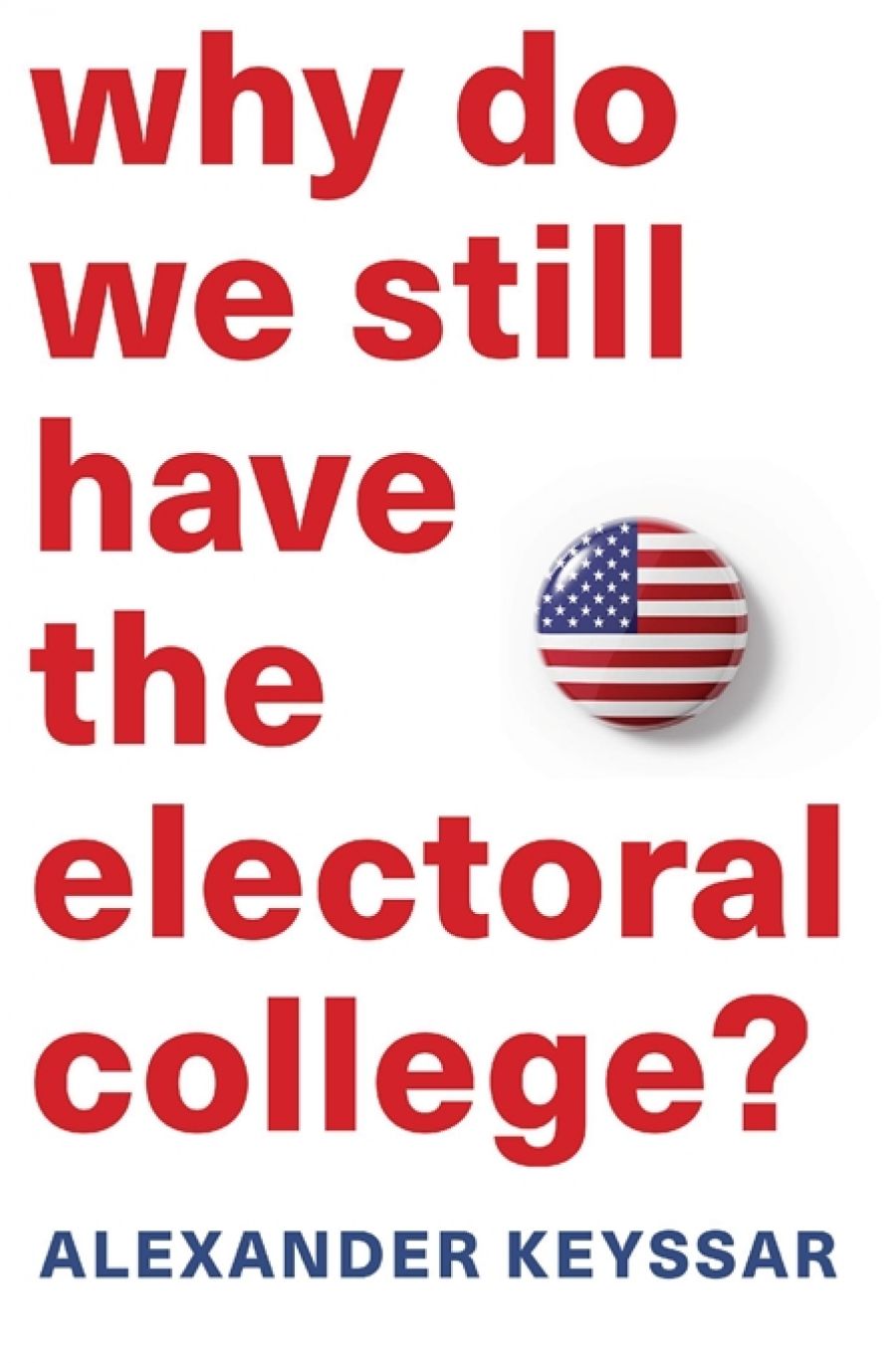
- Free Article: No
- Contents Category: Politics
- Review Article: Yes
- Online Only: No
- Custom Highlight Text:
In 2016, Hillary Clinton received nearly three million more votes for president of the United States than Donald Trump. Despite this sizeable margin, Clinton was not elected. The reason was the electoral college, a method for picking presidents that emerged as an ‘eleventh-hour compromise’ at the Constitutional Convention at Philadelphia in 1787 and that has never been abolished.
- Grid Image (300px * 250px):

- Book 1 Title: Why Do We Still Have the Electoral College?
- Book 1 Biblio: Harvard University Press, $49.99 hb, 531 pp
- Book 1 Readings Link: booktopia.kh4ffx.net/bxYxM
Most states (other than Maine and Nebraska) appoint a slate of electors from the party whose candidate has won the popular vote in that state – a winner-takes-all approach. The candidate who wins the most votes in the state receives all of that state’s electoral votes, which are equal to the number of senators and representatives elected to the US Congress from that state.
The method is further complicated by the prospect of so-called ‘faithless electors’. While most states compel electors to pledge to support the nominee of the political party on whose slate they appear, the electors can still vote for whomever they choose. For example, in 2016, three Democratic electors in California voted for Colin Powell rather than Hillary Clinton, hoping to convince Republican electors in ‘red states’ to vote against Trump. Unsurprisingly, the gambit did not succeed.
Why Do We Still Have the Electoral College? by Alexander Keyssar, is a detailed history of the electoral college and the attempts to change it. It is clear from the outset that Keyssar, a professor of history at Harvard University, is unconvinced of the value of the electoral college. The system is unduly complicated. It also turns the presidential election into ‘an aggregation of state elections’ rather than a truly national election, and entrenches malapportionment by allocating more weight to votes in less populous states. Yet, despite these obvious flaws, the electoral college has remained in place, and the book sets out to ‘explain the survival, the persistence, of this complicated and much-criticized method of electing presidents’.
The system is unduly complicated. It also turns the presidential election into ‘an aggregation of state elections’ rather than a truly national election.
There has been no shortage of attempts to change the system. Prompted by electoral crises, partisan risk, or social change, reformers have proposed amending the electoral college by dividing states into smaller districts or adopting a proportional allocation of votes. Others have proposed abolishing the electoral college altogether in favour of a national popular vote.
None of the myriad proposals has succeeded. Two came closer than others. In 1821, a district election model was approved by the US Senate but failed to achieve two-thirds support in the House of Representatives, by just six votes. In 1969, a national popular vote model was passed by the House, but was filibustered by Southern senators. A motion for cloture narrowly failed to achieve the necessary two-thirds to break the filibuster. As a result, the proposal never reached a vote on the Senate floor. Perceived political interest has, time and again, defeated reform. As Keyssar observes:
Crises, of course, were not the only moments when partisanship complicated the path to reform. Although rarely acknowledged in public, the stances taken by political leaders often reflected their assessments of the impact of a proposed reform on their party’s electoral prospects.
The onerous requirements for constitutional amendment have also assisted defenders of the status quo. Under Article V of the US Constitution, any proposed amendment must first obtain a two-thirds vote of both houses of Congress (or be proposed at a convention called by two-thirds of state legislatures) and then be ratified by the legislatures of, or conventions in, three-quarters of the states.
Keyssar’s examination of the fate of electoral college reform proposals is thorough, though the pattern of defeat for such reform proposals becomes quickly familiar. Nevertheless, the account is enlivened by fascinating episodes in US political history, such as the bitterly contested election of 1876. In that contest, Democrat Samuel Tilden won the popular vote, and a bitter dispute about the qualifications of electoral college members from Florida, Louisiana, and South Carolina arose. To secure the presidency, Republican Rutherford B. Hayes reached an informal agreement known as the Compromise of 1877: if Congressional Democrats supported his election, Hayes promised to withdraw federal troops from the South and end Reconstruction.
Other episodes emphasise the dominance of political considerations. In 1972, President Richard Nixon was supportive of proposals to abolish the electoral college in order to neutralise a perceived threat from George Wallace. As Wallace faded, so too did Nixon’s support for change, particularly when that support risked alienating Southern senators, such as Strom Thurmond.
More recently, presidential incumbency has also been relevant to parties’ attitudes to reform. When President Barack Obama won the electoral college decisively in 2012, Republicans in states such as Michigan, Ohio, Wisconsin, Pennsylvania, Virginia, and Florida began considering replacing winner-takes-all systems with district or proportional elections to counter the perceived benefit to Obama. By 2016, however, when Donald Trump was the clear beneficiary of the electoral college, Democratic hostility to the system was aroused. Republicans, however, interpreted the results ‘as evidence of their wisdom in opposing reform … the Electoral College delivered the presidency to Trump, and popular support for reform [among Republicans] evaporated overnight’.
Overall, the history of attempts to reform the electoral college is characterised by failure. Why Do We Still Have the Electoral College? is a well-researched account of these failures, but offers little hope for future reform. As a work of scholarship, it is to be commended. However, the book is unlikely to appeal to any but the most avid aficionados of US politics.


Comments powered by CComment